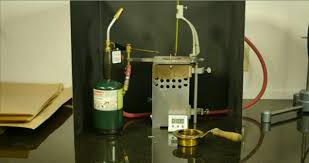The purpose of flashpoint testing is to see whether a particular sample of vapour and air is combustible. It can also tell whether a sample’s flammability threshold occurs at a certain temperature. A material’s flashpoint is the lowest temperature at which its vapours ignite from an ignition source.
Flashpoint testing is essential for evaluating a variety of items, including lubricants and petroleum-based materials. Oil analysis in the oil industry is based on flash point testing.
Why Is It Necessary to Test for Flammability?
Flammable materials are frequently utilized in the manufacture of products and components. They are at risk of fire and explosion regularly. to reduce the danger, it’s critical to test the materials used in processes for their flammability.
For this post, we’ll assume that you’re using PLA.
The lower flammability limit is the lowest concentration at which a material that includes vapour or gas and the air is combustible. The maximum rate of pressure rise for a flammable substance when mixed with sufficient quantities of oxygen. Deflagration index – the volume-normalized maximum rate of pressure rise for a flammable substance.
The flammability testing of material should take into account various factors that can influence its flammability.
Numerous variables influence the desired outcome of your project. In tests, the size and form of the testing container may also have an impact on flammability.
What Are the Benefits of Flash Point Testing?
Flashpoint testing is used for the following applications: Assessing the safety dangers of liquids and semi-solids, including flammability. Classifying these materials depending on their findings. Flashpoint analysis is an effective and efficient procedure in determining the risk of combustion.
The lower the flash point temperature of a substance, the greater its propensity to catch fire. By identifying materials according to their flammability risk,
Flammability is a concern for many materials. To avoid this risk, specifications for different materials will include their flash points to assure quality control and safety guidelines. Maintaining up-to-date safety instructions on packaging, handling, and usage is critical.
The flashpoint test is used to determine whether a liquid is flammable, ignitable, or combustible. A liquid with a low flash point will be more dangerous than one with a higher temperature.
Contaminants can significantly alter flashpoints, particularly when the contaminant is more volatile than the material itself.
Another important application of flash point testing for contamination is in oil analysis. If diesel or petrol fuel contaminates the engine oil, it may act as a thinner, causing the oil’s viscosity to drop significantly. Engine oil’s viscosity is an important feature since it helps to prevent engine components from wear and failure.
A flash test for diesel or petrol in engine oil will determine whether there is any. It can show whether oil thinning is caused by deterioration or contamination when used with a viscosity test.
What Influences the Flash Point of a Substance?
The lowest temperature at which a volatile material’s vapors will ignite is its flash point. A liquid’s vapor pressure is defined as the amount of pressure that a gas exerts above a liquid in a sealed container. The quantity and pressure of vapour released by hot liquids can be increased, for example
Volatile liquids have a high vapour pressure at room temperature. Volatility is measured by the vapour pressure, which is also known as vape juice or e-liquid. The vapour pressure of a gas depends on Boyle’s Law. This relates to the compression and expansion of gas over time while keeping the same temperature. When you expose an ignition source to
The flash point of a material is the temperature at which the vapours from the liquid become volatile enough to escape from the container through convection, radiation, and sublimation.
Testing for Firepointes Using Different Test Methods
The flashpoint test may be done in two ways: with an open cup and a closed cup. Each of these procedures might be more appropriate for various circumstances. One method or the other may be required by certain items or regulations. The sort of product you’re testing should match the testing technique you choose.
There are several distinct approaches for evaluating the flashpoint of oil in terms of open and closed cup categories.
Flashpoint measurement in the Open Cup
The open cup method for flash point testing uses a vessel, or container, that is exposed to the outside atmosphere. When the sample material is placed in the vessel, you gradually raise its temperature and pass an ignition source over it until it flashes and ignites at a particular point. This is known as the sample’s flashpoint.
The Cleveland open cup (COC) is the most popular open cup technique. Other techniques include Tag and Setaflash. The open cup test is less accurate than the closed cup test since vapours are free to escape into the air and might be influenced by local conditions.
This approach can result in higher vapour points when compared to closed cup methods, owing to the lower concentration of vapours.
Closed Cup Flash Point Measurement
In the closed cup method, a vessel is used that is isolated from the surrounding air. You then heat both the container and the material, simulating an unexpected ignition source being introduced into a sealed container, such as a gas tank or other storage device.
Because the confined heat is more likely to cause the sample material to catch fire at an early stage, closed cup testing frequently yields lower flashpoints. Because this lower rate of success favours closed cup techniques, they are now preferred for industrial standards. It’s the most frequent method for testing the burning and flashpoints of all petroleum products with a flashpoint above
Manual or Automated Flash Point Testing?
During manual flash testing, the operator is in command all the way through, monitoring, stirring, and adjusting temperatures. During the test, the operator decides whether a flash has occurred. The alternative is automated flash testing, which uses electronics, software, and mechanical motions to mirror human behaviour. This may decrease labour time and conserve resources.
What Equipment Do You Need for Flash Point Testing?
There is a broad range of flash testing equipment available, for both open and closed cup methods.
Typically, an open cup flash tester will include a heat source (electric or gas), a liquid bath, thermometer and sample test cup.
A closed cup flash tester will include a vessel with a secure lid, a liquid bath, temperature reader and heat controls.
The different methods of open and closed cup testing are suited for different types of material and applications.
For example, the Setaflash Rapid Flash Tester is available in both open cup and closed cup models and is ideal for quality assurance and environmental compliance testing.
The Automatic Cleveland Open Cup flash point tester determines the flash point and fire point of viscous petroleum products.
What Is the Difference Between Flash Point and Ignition Point?
The test for ignition point is distinct from flash point testing. To test for an ignition point, a vessel containing the sample material must be heated in an enclosed oven. The moment when the sample ignites is measured. E659 is the ASTM standard test method for autoignition. The choice of test you apply will be determined by the sort of substance



